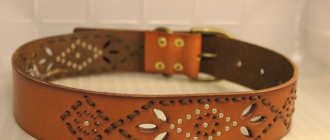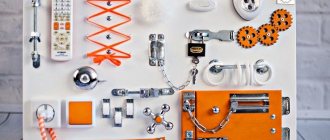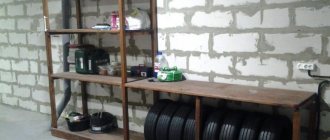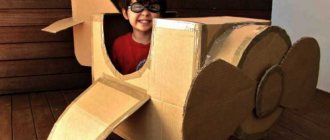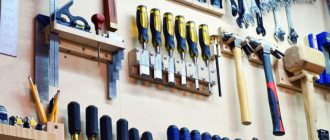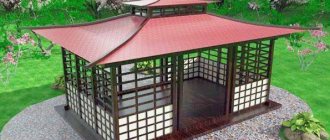Materials and tools for making an espresso coffee machine
Copper parts
- Two plugs with a diameter of 1″
- Four plugs with a diameter of 1/2″
- One tube with a diameter of 1/2″, 75 mm long
- 3 fittings with a diameter of 1/2″ (two of them will be used for making filters)
- One 1″ diameter fitting
- Adapter from 1 to 1/2″ (1″ is male). The adapter will be used to make a teapot
- Adapter from 1 to 1/2″ (1″ - female). The adapter will be used to make the boiler.
- One copper tube with a diameter of 1/4″, about 100 mm long.
Fasteners
- 6mm bolt 75mm long
- 6mm wing nut
For the filler hole: small bolt and nut. The length of the bolt should not be more than 12 mm, the height of the nut should be about 10 mm.
For the heater: small bolt and nut. The diameter of the bolt should be less than the diameter of the 1/4 inch copper tube. The length of the bolt is about 12 mm.
Additional details
- Two rubber gaskets with a diameter of 1″
- Two rubber O-rings used on faucets. The rings are needed to seal the filler hole and the hole under the wing nut
- 10cc syringe
- A small board.
Tools
- Drill
- Hacksaw
- Soldering iron
- Sandpaper No. 150
- Wire cutters
- Pliers
- Hammer
- Drills (diameter 6, 3 and 1.5 mm)
- A few small nails.
Coffee machine manufacturing technology
Boiler
Drill 4 holes in the 1" to 1/2" adapter. Insert the 1/2-inch tube into the adapter and seal.
Note: Use only lead-free solder.
Boiler (part 2)
- Take a 1/4" diameter tube and make a V-shaped cut about 25mm from one edge
- Bend the tube at the cut site at a right angle
- Solder the bend
- Use a hammer to flatten the long end of the tube
How to brew coffee in a coffee maker
Brewing coffee is not difficult if you first get acquainted with all the variety of machines in the coffee world. How to use a coffee pot and how to prepare a delicious drink?
Drip
Drip coffee machines can be used in a large family when it is necessary to prepare many servings of an aromatic drink at once. A drip coffee maker works on the principle of passing hot steam through ground coffee beans and special filters. This is ideal for Americano. The prepared drink drips into a common jug, from which it is then poured into cups.
The drip coffee machine is suitable for a large family.
The device has a heating function, so the container with ready-made coffee can remain hot for a long time:
- pour the required amount of water according to the scale on a special container;
- pour the required amount of ground coffee into the filter;
- set the program;
- Depending on the model, the coffee will be dispensed into a separate flask or directly into the cup.
In this device, coffee stays hot for a long time.
Capsule
A capsule coffee maker offers a convenient selection of ready-made drinks. Here you can brew latte, Americano, cappuccino and others. The preparation process begins with placing a portioned capsule with ground coffee. Its packaging is pierced and hot water is forced through the ground grains under high pressure. The strength and taste of the finished drink will directly depend on the selected pressure. Of course, you have limited choice in capsule manufacturers.
You can make ready-made drinks in a capsule coffee maker.
But you can choose your own brand that fully meets your requirements and taste preferences:
- turn on the machine and fill in the required amount of water;
- place the capsule in a special receiver;
- Place the cup and wait until the finished drink comes out of the nozzle.
After preparation, the coffee is served in a glass.
Geysernaya
The geyser coffee maker is designed for lovers of strong and rich coffee taste. The drink does not need to be further strained or settled, since this preparation method does not leave sediment in your cup. Hot water is passed through the poured coffee under the influence of steam.
A geyser coffee maker produces a coffee drink without sediment.
The coffee pot is easy to use, easy to disassemble and clean from grounds:
- pour water into the lower compartment to the desired level;
- pour ground powder into a special funnel;
- assemble the device according to the instructions and plug it into the network;
- under steam pressure, the coffee drink will flow into the upper container;
- after the machine is turned off, the drink is poured into the cup.
The device is quite easy to use.
Rozhkova
This coffee maker got its name thanks to its removable horns. These are models for gourmets, those who like to experiment with drinks and professional baristas. Ground coffee is poured into the cone and compacted as much as possible. Here you yourself vary the grinding size of the beans, cooking time, water temperature and other factors. Each time you will receive a finished drink that is different in taste and strength.
A carob coffee maker allows you to experiment with flavors.
You can create rich foam, wonderful espresso and balanced cappuccino:
- if the model is equipped with a function for self-grinding beans, then pour them into a special container;
- Place ground coffee in the cone and press firmly;
- set the required parameters for water temperature, pressure supply and others;
- place a cup under the nozzle spout;
- If desired, froth the milk using a cappuccino maker.
If desired, you can make a thick foam.
Types of disposable paper filters
There are many modifications on the market that differ in paper type, shape, size and other characteristics. The choice depends on the type and brand of coffee maker, your preferences, budget, etc.
Filter paper
The production uses bleached and unbleached paper, as well as bamboo.
- Natural filters, made from unbleached brown paper. This is the natural color of cellulose, which is obtained from wood. There is no glue in the seams and no bleach is used. It is believed that this is the most environmentally friendly option, but coffee lovers may feel the taste of cardboard in the products of some manufacturers. To get rid of it, you first need to pour boiling water through the filter, drain the water, and then pour in the coffee and brew it as usual. If you notice a taste, repeat the washing procedure twice. If it doesn’t help, switch to filters from another manufacturer.
- White paper filters can be bleached with chlorine dioxide (ECF) and oxygen or ozone (TCF). The bleaching method is indicated on the packaging. Oxygen bleaching is considered to be less harmful to the environment. For chlorine, it is not pure chlorine that is used, but its compounds, and the technology is designed in such a way that there is no chlorine left in the filters; using them is completely safe for health. Bleached filters do not introduce any foreign smell or taste, but notes of cardboard (especially in inexpensive options) can be felt, and in this case, rinsing with boiling water should also help.
- Bamboo ones are produced mainly by Melitta, although you can find options from Aliexpressa made by little-known manufacturers. In this case, bamboo replaces most of the cellulose, which causes less harm to the environment and eliminates the cardboard taste in the drink. They usually cost more than their cellulose counterparts.
Filter shape
Depending on the type of coffee maker and the options for preparing the drink, filters can be flat-bottomed, conical, with smooth or ribbed walls.
- With a flat bottom - more suitable for brewing drip coffee directly in a cup, although they can also be used in coffee makers.
- Conical - for a drip coffee maker, but can be used for both a Chemex and a cup.
- Filters with ribbed walls are the best choice for pour overs, as they distribute the liquid evenly, but they are also used for cups, since the size is easily adjusted.
If necessary, filters of different shapes can be interchanged, but care must be taken to ensure that the product does not move too much or become deformed in the process.
Filter size
The dimensions of the filter bags are always written on the packaging. And they usually indicate the appropriate size on the holder itself, inside the coffee maker. For example, the Melitta brand indicates 1x2 or 1x6 on the coffee maker, which means that in one fill the filter can hold the amount of coffee intended for 2 or 6 cups. In other coffee makers, it is also usually calculated approximately by the number of cups; the most common options for disposable coffee filters are No. 2 and No. 4 (for 2 and 4 cups, respectively). Typically, No. 2 is used for coffee makers with a capacity of 600-800 ml, and No. 4 is used for a capacity of about 1-1.2 liters.
For brewing in a cup, you can take bags numbered 1 or 2.
What is a coffee machine
This is a type of household appliance that is used at home. It is capable of preparing not only traditional black coffee, but also other drinks based on it. The machine is fully automated, manual control is allowed, but only minimal
Knowing how to choose the right coffee machine for your home is important; the quality of the desired drink will depend on it
There are many types of coffee machines. Each of them has its own characteristics and capabilities. Many models can and do perform the following list of actions:
- grind coffee beans;
- determine the required ratio of water and raw materials for brewing;
- change the grind size;
- form briquettes from coffee powder;
- they heat the water, then passing it or its vapor through the coffee;
- remove the already used grinding into a specially designated tank;
- can prepare not only black, but also other types of coffee;
- can self-clean;
- automatically ends the process when the coffee is ready.
People very often confuse a coffee machine with a coffee maker. These are two completely different devices. The first device is completely automated, preparing coffee from start to finish without human intervention. The second one works completely differently. Here the person himself pours in the required amount of ground coffee, pours it with water and, heating it on the stove, waits for the drink to be prepared.
Why doesn't the coffee machine turn on?
If your coffee maker won't turn on, it could be due to many problems. Among them, the most common ones are most often identified.
- Electrical cable is bent or broken. To eliminate the defect, it must be replaced.
- When there are sudden power surges in the network, the fuse trips and the coffee machine stops turning on. In order for it to work again, this part must be replaced. It is recommended to use a stabilizer that will prevent damage to household appliances.
- If the coffee maker is running continuously, it may overheat. In this case, the thermal protection will work and turn off the device. In this situation, you just need to let the coffee machine cool down.
- With prolonged use, scale forms in the coffee maker and coffee deposits appear. All this can lead to open contacts. To start brewing coffee again, you need to thoroughly clean the device and restore the contacts.
- Control module failure. This defect is the most serious, and to correct it you will have to seek the help of professionals.
However, the problem is not necessarily with the coffee maker. First you need to check the following.
- Make sure there is electricity in the apartment. It is quite possible that the plugs in the electrical panel were knocked out.
- The machine may turn off due to clogged filters. They need to be cleaned or replaced. After this, the device will operate normally.
What determines the taste of brewed coffee?
It is not always possible to brew espresso as tasty as we would like. This is due to the fact that the use of coffee makers has certain features. The taste of the prepared drink is influenced by several factors:
- water. You need to use clean, purified or bottled. The presence of impurities is unacceptable;
- grinding degree. The finer the coffee fractions, the stronger the drink;
- dosage. The strength directly depends on the selected proportions of crushed grains and water;
- preheating the dishes. If the finished espresso is poured into a warm container, it fully reveals its taste and aroma qualities.
The difference between cappuccino and other drinks
There is a significant difference between cappuccino, latte, mocha and other drinks. Thus, the serving method is different - the average capacity of a cup of cappuccino is 180 ml, while the volume of a cup of latte or mocha is at least 240 ml. The difference also lies in the type of foam - in cappuccino it is denser and thicker, in other coffee drinks it is lighter. And of course, the main difference between cappuccino and other coffee-based drinks is strength and taste. For example, latte and mocha have a smooth and soft taste; coffee is practically not felt. Cappuccino has a brighter coffee taste due to a shot of espresso.
Popular models and manufacturers
Popular brands are fighting for the right to be first in the world of specialized coffee machines. There are several manufacturers that successfully occupy first positions in the market for sales of coffee makers and coffee machines:
- The Italian concern DeLonghi is distinguished by its minimalist equipment design. And their coffee machines amaze with their rich functionality. For example, the famous model ECAM 44.664.B has an automatic cleaning system for the device.
- The Italian brand Saeco confidently holds the first position among manufacturers of high-quality coffee makers for the home. The Incanto HD8918/09 model has 5 programs for the strength of ready-made drinks.
- Philips relies on futuristic design and high quality coffee machines.
- Among the domestic brands, one can note the Polaris coffee maker. Instructions for use, intuitive operation and sophisticated design have made it a top seller.
Which device should you choose?
Most experts say that a coffee maker is the best option for home use. It has a simple mechanism of action and does not require special setup or study of instructions.
Manufacturers often refer to ordinary modern coffee makers as coffee machines. This is a kind of advertising ploy to attract attention. The main difference between these devices is that the coffee machine always has a bean grinding function. Coffee makers do not have this feature.
There is a misconception that coffee makers are low cost. Modern high-quality devices of this type, which are capable of preparing coffee no less tasty than coffee machines, often have a high cost. At the same time, the main advantage of the machine is that it provides many more possibilities.
The choice of device is an individual question, the solution of which depends on the needs of each buyer. If the device is needed solely for making coffee, then it is best to limit yourself to a coffee maker. If you want to make cappuccino and other drinks, then a coffee machine is suitable for you.
Patented version of a homemade coffee machine
Let us note right away: the answer to the question of how to make a full-cycle coffee machine with your own hands has not been found. The most effective option involves separating operations. A grain mill is made separately; the simplest solution can be a steel screw installation for grinding spices. There are also devices with electric and manual drive, but there is not much difference between them.
The prepared ground coffee is poured into a homemade coffee maker. One of the interesting developments, for which a patent has even been received, is a device designed by engineer Vladimir Oreshkin. This is a durable, double-walled chamber made from solid billet and equipped with an outlet for draining the finished drink.
To prepare espresso, place a steel container with water inside and add a portion of ground coffee. The lid closes securely, it does not have sealing gaskets - the grinding principle is implemented. When the container is heated, the full effect of steaming the coffee is observed, which allows you to achieve the rich taste and aroma of espresso. The original model of the homemade coffee maker was designed to be installed on a gas stove.
Based on this development, many craftsmen have come up with improved versions of coffee makers. They added their own heaters, both electric and using alcohol and paraffin burners.
Controversial designs
On the Internet you can find more than one or two options for making a coffee machine with your own hands. For example, a mini-coffee maker for making espresso wanders from forum to forum, which has everything: its own alcohol burner for heating water, a container for coffee, and a convenient faucet for draining the drink. At the same time, the device can be easily placed in a pocket. You can see this mini coffee maker in the photo.
However, a specific design requires the use of welding, copper tubes, unique components, and empirically selected sizes. Therefore, it is impossible to guarantee that everyone can make this coffee maker. Particularly because an alcohol burner is used as a heater, but no parameters for modifying the device for using kerosene, gasoline or paraffin are given.
There are also successful projects that look almost like a serial industrial product, for example, there is a lively discussion on the Internet about a stylish coffee maker from a German artisan.
Its design contains many components taken from different devices: coffee mills, heaters, even a housing from a household appliance. The product is unique, and attempting to replicate it may not always be successful.
How to make latte macchiato
Description and other features
In addition to the classic recipe, there is an alternative one, which is described in the article “What is latte macchiato.” Next, we will consider only the basic nuances and how to make a drink in a coffee machine.
"Macchiato" means "spot" in Italian. The barista gave this name to the drink because of its appearance. After ready-made espresso is poured into hot milk, brown spots remain on the surface. In the bar menu you can find the name “macchiato”.
Interesting! Why can coffee sour?
This coffee can be prepared at home in a Delonghi, Krups and Bork coffee machine.
The main difference between a latte macchiato and a standard drink is the order of ingredients - milk is poured into the glass first.
This latte recipe features a large volume of milk - the ratio to coffee is 3:1. And also a high top layer - a third of the volume of the entire portion.
Recipe
Brew a shot of espresso. Prepare the foam as in the standard method and pour it into a tall glass 2/3 full.
Carefully pour the espresso into the milk in a thin stream, exactly in the center so that the layers do not mix.
At first glance, this is a simple recipe. But even those who know how to make coffee correctly cannot get it perfect the first time.
The main features of latte macchiato are dense, homogeneous foam without bubbles, light beige color of the coffee layer and creamy, balanced, without bitterness, taste.
The most popular coffee recipes
Making coffee with a drip coffee maker is easy. In such a unit you can brew classic espresso, and use it to create even more sophisticated drinks.
Espresso
The list of products required for making espresso is minimal:
- 9 g ground coffee beans;
- 30 ml water.
The drink is prepared in a drip coffee maker according to the following principle:
- Coffee powder is poured into the filter.
- Water flows into the rear reservoir.
- The device turns on.
- When the liquid moves to the lower reservoir, the finished drink is poured into heated cups.
Latte
When making a latte you will need the following ingredients:
- 50 ml espresso;
- 200 ml milk;
- a pinch of cinnamon;
- 3 g chopped nuts.
Cooking steps:
- Brew espresso coffee in a coffee maker and pour it into a tall glass.
- Beat the milk with a blender or mixer.
- Pour the resulting mixture over the espresso.
- Place milk foam on top.
- Sprinkle the surface with nuts and cinnamon.
Viennese cappuccino
To make cappuccino you will need the following products:
- 50 ml of espresso prepared in a coffee maker;
- 50 ml whipped cream;
- 20 g chocolate.
Cappuccino coffee recipe:
- Heat the milk on the stove and pour into a glass.
- Slowly pour the finished espresso into the same container.
- Place whipped cream on top.
- Decorate the surface with chocolate chips.
Irish coffee drink
The original drink, popular in Ireland, contains the following components:
- 60 ml espresso;
- 20 g sugar;
- 20 ml water;
- 40 ml cream;
- 30 ml whiskey.
An Irish cocktail is prepared as follows:
- Brew espresso in a drip coffee machine.
- Mix water with sugar and bring to a boil.
- Pour the resulting syrup into coffee.
- Add whiskey to the composition.
- Spread whipped cream on the surface.
Geyser coffee machine
The simplest one to make is a geyser-type coffee machine. The easiest way is to make the main unit responsible for making coffee. This homemade coffee maker looks something like this:
- At the bottom there is a water container.
- A two-chamber block is installed on it, the lower part of which is a container for ground coffee, the upper part is a compartment for the finished drink.
This homemade coffee machine works simply: when the liquid is heated, steam passes through the ground coffee, and the resulting drink enters the upper compartment through a vertical tube. As it accumulates, you can pour it into a cup and enjoy the taste. The design diagram is shown in the photo.
The operating principle of a geyser-type coffee maker
A homemade coffee machine of this class is equipped with heating elements made of nichrome wire. In practice, to reduce labor intensity, you can take a simple route - adapt the lower heating plate from an electric kettle. This solution is very beneficial:
- temperature is controlled;
- The internal safety system, which is present in many heating elements, will prevent the possibility of accidents.
There were also coffee machines for motorists, capable of preparing a cup or two of aromatic drink using a cigarette lighter.
Common problems and solutions
There is no point in being tied to certain models of coffee machines. Each brand and model has its own characteristics, and repairing a specific coffee machine may have unique steps. For example, Gaggia Syncrony Logic machines use strictly roasted coffee beans, and a number of problems are associated with their lack of quality. Delonghi repairs in most cases are due to the use of unfiltered water and the lack of repeated decalcification procedures. From time to time, Krups capsules get stuck tightly in the supply path. Therefore, it is worth considering typical faults common to all coffee machines.
The car won't start
First, you should check the condition of the power cord, look for fraying, the presence of areas of sharp bending, or breaks. If damage or suspicion of its presence is discovered, it is worth changing the power cable.
Water is leaking in the horn area
Due to calcination, the O-ring no longer provides a tight seal. It is worth unscrewing the horn and washing the rubber part with special means to remove calcium deposits. If the ring has lost its elasticity or cracks, it needs to be replaced.
The device does not start
Errors on the screen and incomprehensible behavior during initial startup can be caused by clogged contact groups. If the car is equipped with a push-button remote control, you should try to carefully remove the decorative panel with a narrow screwdriver and check the condition, clean it with alcohol, and clean it if the plates are open to access.
In cases where the machine is controlled by a touch panel, you should contact a service center; difficulties may arise both in the control unit and in the multilayer contact group itself.
The reason that the device does not start and displays an error may be that one of the sensors is dirty. If a certain model of machine allows complete disassembly and access for cleaning, it is worth doing this; decalcification using special means will also not hurt.
Coffee is not brewed properly
A whole group of circumstances (decreased water flow, strange sounds, hissing, dose violation) is associated with the accumulation of contaminants and calcification. The first step is to run the water through the cappuccino maker. This eliminates air pockets. If this does not help, it is recommended to carry out decalcification with the following cleaning of the mesh with a stiff brush, the tubes with a needle, removing all blockages, coffee residues and grease. But the reason may also be the failure of the pump - then specialist intervention will be needed, it is worth contacting the service for a replacement.
No coffee grind
The coffee machine is disassembled, all clogs in the mill are removed using a vacuum cleaner and a brush, after which the device is assembled and set to the highest grinding dose mode. To control and completely remove residual contaminants, it is worth boiling several cups, then set the machine to normal mode. If this doesn’t help, it’s best to contact a specialist; maybe the problem is mechanical damage to parts of the mill structure.
There are difficulties that will require replacing individual parts to eliminate them. If you have the necessary technical abilities, you can do this at home - for most modern coffee machines, spare parts can be found in stores, on the market, and in service centers. But if water appears under the device, and you simply don’t have the skills to disassemble, replace tubes and check the density, you should immediately disconnect the device from the network and call a specialist.
Repair of Delonghi, Saeco, Krups coffee makers.
Any electronic device can fail over time. Repairing coffee makers from Delonghi, Saeco or Krups is quite easy to do yourself. This kitchen home appliance is considered one of the easiest to repair and operate.
How to use a drip coffee maker correctly
A drip coffee maker can quickly prepare Americano with great taste and aroma. A good result can be achieved by first studying the operating instructions.
Those who first encountered this device should be guided by the following rules:
- Connect the device to a voltage source.
- Water is carefully poured into the tank.
- A filter is installed in the container. Next, it is filled with ground coffee in the amount of 1 teaspoon per 0.1 liter of water. In the future, the dosage can be adjusted to your own taste.
- The coffee pot for the finished product is installed on the platform.
- Press the start button and start the device. Further, all processes are performed automatically.
- Wait until the drink is ready and remove the jug from the stand.
- It is advisable to rinse a reusable filter immediately before it dries out, and simply throw away a disposable filter.
Exact adherence to the rules does not always lead to the desired result. Preparation, which is also carried out in a certain order, is of great importance. Much depends on the coffee itself, the water used, various additives and other factors.
Malfunctions of carob coffee makers
A semi-automatic or automatic coffee machine is a rather complex device with fine tuning. Repairs will not be cheap, but tampering with the device yourself can cause considerable harm. You should not repair the electrical system unless you have the appropriate training and skills in using instrumentation. Everything related to electronics and heating elements should be left to specialists, especially if the warranty period has not yet expired.
A carob coffee maker, the function of which is only to prepare a drink using ground coffee, is also a serious mechanism. But if adding water, filling and cleaning the horn, emptying the drip tray, and flushing all systems from contaminants is done manually, then you can fix some problems yourself.
Important nuances of equipment
When purchasing a machine, you should pay attention to the following details. Functionality
People come to the cafe not only to drink a cup of espresso, but also there are lovers of Americano, cappuccino, glasse, ristretto, latte, mocha, mocaccino and other coffee drinks. The more variety of drinks a coffee machine can prepare, the more visitors you can attract
Functionality. People come to the cafe not only to drink a cup of espresso, but also there are lovers of Americano, cappuccino, glasse, ristretto, latte, mocha, mocaccino and other coffee drinks. The more variety of drinks a coffee machine can prepare, the more visitors you can attract.
Display. Modern models of coffee machines are equipped with a display. This feature of the equipment will simplify the work of the barista, because the screen displays data on the operation of the unit, the need to add water or coffee, as well as the need to clean the device.
Heating. There is a cup warming function, which can be replaced by simply pouring boiling water over the dishes from the coffee machine. But the heating of the stove, which will not allow the finished drink to cool, is difficult to replace. Keep this in mind when choosing equipment.
Adjusting the coffee grind. The variety of taste properties of the drink depends on the size of the coffee grind. Most recipes call for different grind sizes. So, espresso is made from finely ground coffee, while Americano requires larger particles.
Coffee grinder
Pay attention to the material from which the coffee grinder millstones are made. Metal ones will last a long time, but will create some inconvenience due to noise during operation
Ceramic ones work quietly, but their service life is short.
Pre-wetting the coffee, immediately before preparing it, helps improve the taste and aroma of the drink.
Liquid dosing. This function will give you the opportunity to experiment while making coffee. You can add milk, ice cream, syrup to cups that are not completely filled, which will expand the range of coffee drinks.
Dosing coffee per serving will allow you to adjust the richness and strength of the drink.
The ability to prepare several cups of different coffees at the same time will increase the speed of customer service.
Pressure regulation. Using this function, you can prepare light coffee with a minimum pressure, and by setting the pressure to maximum you can get a strong drink.
Automatic decalcification system. Simply put, descaling and removing coffee oils, which you can do yourself. This procedure is required after every 200 cups of coffee. Some types of equipment will report this themselves, thanks to a built-in indicator. If there is none, you need to monitor the counter of prepared cups yourself.
Instant steam. This function is provided in units with two boilers. One of them operates in water supply mode, and the second supplies steam.
Quick steam. The presence of this function allows a coffee machine with one boiler to switch from water supply mode to steam supply mode in the shortest possible time.
Cappuccino maker. This is a device for frothing milk using steam. There are varieties:
- Auto. Has two tubes. One is attached to the steam supply tube, the other is lowered into a container with milk.
- Paranello is a hand-held device that is also connected to a steam supply tube. The barista is in charge of frothing the milk.
- The Milk Island Cappuccino Maker is an automatic steam device. The built-in whisk begins to rotate under the influence of steam and froths the milk.
Basic criteria for choosing a coffee machine for the office
Which one to choose? Before purchasing, be sure to familiarize yourself with the main technical characteristics and additional features.
Balance this with your wishes so as not to overpay for unnecessary functionality.
Performance. The speed of preparing a drink in the office is an important aspect, since slow operation of the equipment will create a queue.
Reliability. Few people treat technology in the office with care. Choose a coffee machine from a range of well-known manufacturers with a body made of durable materials
Please note the warranty period is at least two years.
Ease of use. When one click gives results
Many employees can get confused among the numerous buttons and controls. The optimal solution would be technology with a large screen, touch controls and a clear interface.
Volume of the grain bowl. The larger the team, the larger the grain container should be. For a small company, a 300 g bowl will be enough, for a large company – from 800 to 1000 g.
Auto cleaning. Coffee machines require careful care and regular cleaning, which is not always possible in an office environment. Ignoring cleaning is fraught with dense dirt, overheating and further breakdowns.
Cappuccino maker. For those who do not like strong coffee, preferring cappuccino, latte or macchiato.
Step-by-step instructions for use
Before using the coffee maker, it must be prepared for use. A new device sometimes smells like plastic and may emit other technical odors. Therefore, the following steps must be taken beforehand:
- Water is poured into the entire volume of the tank. There is no need to install a filter or pour powder inside the container.
- Turn on the device and wait until all the water follows the intended paths inside the coffee maker and collects in the coffee pot.
- The device turns off and remains in this form along with water for 15-20 minutes.
- The procedure should be repeated at least 3 times. During this time, foreign odors will completely disappear and the device can be used for its intended purpose.
Before you start using it, be sure to read the instructions on how to use the coffee maker. In any case, all actions are performed in several stages:
- Filling with water. It is poured at the very beginning, in the quantity necessary to obtain certain qualities of the drink - strength and taste. Monitor the upper level and do not overfill. During filling, water should not get on other parts of the device.
- Filter installation. Placed in a special container. Can be reusable - nylon or metal. Disposable paper filters are often used - more convenient and effective. Thanks to their use, it is possible to completely avoid the unpleasant tastes characteristic of reusable elements.
- Adding ground coffee. Typically, 1 cup requires 2-3 teaspoons. The required amount of powder is poured directly into the filter. The jug for the finished drink should be in its place. The device turns on, the coffee is prepared and collected in a container. The whole process takes on average 4-10 minutes. If there is no automatic shut-off, you must turn off the coffee maker yourself.
Caring for the device
Caring for a geyser coffee maker is simple. With the help of useful recommendations, you will be able to increase the service life of the device and preserve the taste of your coffee.
- After use, cool the device and only then begin to clean it.
- Parts should be washed by hand and should not be used in a dishwasher.
- Do not use rough sponges or detergents containing chlorine or vinegar. Aggressive substances have a detrimental effect on the metal; with further use, the drink develops an unpleasant “metallic” taste.
- The filter is washed under running water, sometimes using dishwashing detergent or baking soda.
- After washing, wipe the parts with a dry, clean towel.
- Over time, a dark coating appears on the inner surface of the device due to coffee oils. There is no need to clean it: the oil residue prevents oxidation of the metal and makes the coffee richer.
- Make sure the safety valve is clean: clogging can lead to an explosion of the device.
- Store the coffee maker disassembled.
OLYMPUS DIGITAL CAMERA
Electric coffee makers sometimes lose their settings (this can be noticed by the brewing process slowing down). In this case, they should be corrected.
In a geyser coffee maker, you can prepare coffee regularly for many years if you follow basic care rules, but the silicone gaskets and filter need to be changed about once every five years: these parts are more damaged than others due to temperature changes.
Types of coffee machines
All coffee machines differ from each other in design and functionality. They can be equipped with a cappuccino maker and perform almost all necessary operations automatically. According to their qualities, coffee machines are divided into several categories:
- Standard coffee machines. As a rule, these cars are included in the budget segment. Most of them do not have a cappuccino maker, so drinks with milk cannot be prepared. Almost all have built-in coffee grinders, which distinguish coffee machines from regular coffee makers.
- With manual cappuccino maker. This function is performed by a separate tube equipped with a special nozzle for supplying hot steam. The panarello nozzle expands the steam stream, accelerating the formation of foam. The main disadvantage is the need to manually froth the milk. Although this process is quite easy, it is time consuming. Thus, in these coffee machines, the foam is first created manually, and only after that it is used for its intended purpose. However, coffee machines with a manual cappuccino maker allow you to save a lot of money when purchasing, especially when you plan to prepare dairy drinks not very often.
- With automatic cappuccino maker. These are already more advanced and functional coffee machines. The required dosage of milk is determined and measured automatically. It is possible to select the sequence of mixing cappuccino ingredients. The only manual action is to move the cup of coffee under the frothed tube. In many machines, the milk container is made removable and stored in the refrigerator until ready.
- Superautomatic machines. The most expensive machines capable of preparing the most delicious coffee drinks. Wide functionality covers almost all work processes and brings them into automatic mode. The coffee beans are only poured in manually, water and milk are poured in. After this, the required mode is selected and all that remains is to wait for the final result. All containers for grains and liquids are large and do not require frequent refills. In expensive and professional models you can even prepare hot chocolate and other exotic products.
What parts does a coffee machine consist of?
The design of coffee machines varies greatly depending on the brand and model. There is a very affordable Bosch TAS series, which is provided with a minimum of functionality, and there is a line of Grand Barista models from Saeco, consisting of expensive devices filled with complex electronics and used for mass preparation of coffee in catering establishments and restaurants. But in general, all parts can be divided into functional groups, which are also called assemblies. In this sense, the design of the Delonghi Magnifica coffee machine will be no different from the equipment of a Bosch or Saeco device.
Coffee machine device
So, the main nodes:
- Container for storing ground coffee or roasted beans.
- A device for grinding grains or a capsule for tablets. Based on the presence of one or another unit, two types of coffee machines are distinguished: capsule and grain. The variety seriously affects the quality of the coffee prepared and the design of the machine.
- Container for water.
- A device that dispenses ground beans or coffee powder for a grain variety.
- Coffee machine brewer.
- Container for collecting spent coffee substrate.
- Boiler for boiling water.
- A system of tubes and pumps that force water to move through the device.
- Holder for tablets or capsules, filter.
- Tray for draining water and coffee.
- The microcomputer circuit that makes this entire system work as a single unit.
- Electronic control and display panel.
Bean coffee machines sometimes break down more seriously than capsule coffee machines. If the built-in coffee grinder of a grain machine stops working, repairs will be expensive.
Coffee beans
Depending on the complexity of the entire system and the scope of its functionality, its details also become more complex. This applies most of all to computer boards. In terms of computerization and software, the design of the Bosch coffee machine of the aforementioned TAS 1200 series is much simpler and uncomplicated than that of the Delonghi Primadonna series.
The main unit is the brewing device - it is in it that the resulting filter from coffee beans passes steam or water through itself. They are sold separately so that if the “native” unit breaks down, it can be replaced. But for each model of each brand they differ in structure and dimensions, so the brewing device of a Saeco coffee machine will not fit a Bosch coffee machine.
Ground coffee
Drip coffee maker - what is it?
The drip coffee maker has a solid history. For the first time, a device that prepared coffee by straining hot water through ground powder was brought to the attention of the public back in 1800. The inventor of the method is a church minister, Parisian Archbishop Jean-Baptiste de Bellois. The invention was modernized, redesigned, and patented many times in different countries. But the principle remained the same. With the evolution of electrical appliances, the drip coffee maker acquired its own heating source and acquired the appearance we are familiar with.
Today's drip machine is an electric device with a heater in which hot water passes through a filter containing ground coffee and enters a reservoir. The strength and aroma of the drink is achieved through the slow passage of water through the coffee, during which it is enriched with the taste and aroma of the ground beans.
Which ground coffee should you choose?
Much depends on individual taste and aroma preferences. But some manufacturers offer a product designed specifically for filter coffee makers.
Lavazza has been a favorite coffee brand of Italians for over a century. The company exports beans from all over the world and masterfully creates a line of high-quality products in accordance with its long tradition. Try, for example, Lavazza Filtro Italiano Delicato. This is a unique blend that maximizes the taste and aroma if this coffee is brewed in a drip coffee maker. A mixture of Brazilian and South American Arabica beans with the addition of Robusta is distinguished by its versatility in taste. Honey-chocolate shades are complemented by a delicate nougat flavor. Available in half-kilogram vacuum packaging.
Lavazza ground coffee
Finnish Paulig is known for the high quality of its product. In Scandinavia they like to brew coffee in drip coffee makers. The manufacturer recommends using, for example, Paulig Presidentti Original - a mixture of 100% Central American and Brazilian Arabica. A balanced taste with barely noticeable sourness is complemented by notes of currants.
Paulig ground coffee from Finland
Illy is a well-known Italian brand that creates a premium product and has earned positive reviews from coffee lovers. The manufacturer's line includes coffee for drip coffee makers. This is Illy Filter Coffee - a mixture of nine of the best Arabica varieties with a bright taste, where subtle sourness and light bitterness are harmoniously combined with the sweetness of a long chocolate aftertaste. Packages with a bronze stripe contain coarser beans and are perfect for filter coffee makers.
Illy ground coffee
Mövenpick is a European brand that combines German and Swiss coffee traditions. Which coffee for a drip coffee maker to choose from the manufacturer’s line? Try Mövenpick Der Himmlische. This is a mixture of the best beans of Indian, African, Central and South American Arabica, the name of which is translated from German as “heavenly”. It has a rich taste and intense aroma. Packaged in vacuum packaging weighing half a kilogram.
Mövenpick ground coffee
Dallmayr is a German brand that purchases selected grains from different parts of the world. To brew coffee in a drip coffee maker, choose, for example, the Dallmayr Prodomo. This is a soft but aromatic coffee. It is created from highland Ethiopian Arabica. It has a deep taste without bitterness, but with a slight sourness and a sweet aftertaste.
Dallmayr ground coffee
Kimbo - this Italian brand purchases premium raw materials exclusively in Latin America and uses uniform frying technology when processing them.
When choosing coffee for your drip coffee maker, pay attention to Kimbo Aroma Classico. This is a blend with the classic proportions of Arabica and Robusta with a strong but soft taste.
Kimbo Espresso
Essse is an Italian brand, the name of which in the form of three “s” - the first letters of Italian words - reflects the main principles of the company: knowledge, competence, specialization. To brew the drink in a drip coffee maker, you can choose Essse Americano - a blend of Arabica and Robusta with an intense flavor and moderate strength. Produced in a tin can.
https://youtube.com/watch?v=vKYkaeAiqg4
So, using a filter coffee maker couldn’t be easier. You already know how much and what kind of coffee to put in the filter. All that remains is to fill the tank with high-quality water, adjust the power, wait a few minutes and enjoy delicious hot coffee!
Capsule coffee maker device
The appearance of capsule coffee machines may vary significantly between different models. The range starts with the simplest budget coffee makers and ends with devices controlled via a smartphone.
However, the main structural elements are present in all machines:
- Cold water container located at the rear.
- Pump.
- A heating element.
- A hollow needle of small diameter. Hot water flows through it under pressure.
- A system that brews and discards the used capsule.
- Control block.
Hermetically packed capsules contain ground coffee beans in an amount of 5-9 grams. The packaging is made of aluminum or food-grade plastic. Sealed containers can be stored for two years without the product losing its original qualities. After the casing is pierced, all the aromas and flavors of the coffee are absorbed into the hot water, turning it into a finished drink.
Bosch TCA Benvenuto
A common problem with Bosch TCA Benvenuto coffee machines (especially older models) is the breakdown of the position sensor of the brewing unit and the sensor for the presence of grain in it. At the same time, there is dried coffee in the tray of the coffee machine. In such a situation, the sensors need to be repaired at a service center.
Also, Bosch coffee machine repair technicians note that models of the TCA Benvenuto series are very picky about dirt. If they are not properly cleaned of waste cake and coffee oils, then they quickly fail due to the additional load on various multifunctional units. For example, untimely cleaning leads to damage to the drain valve.
Owners of Bosch TCA Benvuento coffee machines should not neglect their care:
- decalcification (every 200-300 cups of coffee depending on water hardness),
- cleaning the brewing unit from coffee oils (every 2-4 weeks),
- cleaning the automatic cappuccino maker and milk jug (every 2-3 days),
- lubricating the moving parts of the brewing mechanism (every 500 cups of coffee).
Do not start cleaning the brewing unit and descaling without carefully reading the instructions for using your Bosch coffee machine with a step-by-step description of these procedures.
DIY coffee maker. Step-by-step instructions (photo+video)
Chemex devices are an easy way to brew coffee that tastes no different from what you can get from a coffee machine. Plus, it's easy to clean—once you've brewed a cup of coffee, all you have to do is throw away the filter and put the glass funnel in the dishwasher. The main feature of our coffee maker is that the copper tubes are connected to each other with epoxy resin, so soldering equipment and special skills are not required. The copper pipe can be cut with a pipe cutter, making our coffee maker possible without a single power tool. Plus, it is also an excellent decorative element for your loft-style kitchen.
DIY coffee maker required materials:
- 60 centimeters of ½ inch copper pipe.
- two tees, three elbow fittings and two plugs (make sure the fittings are the correct diameter for the copper pipe you choose).
- 1 glass funnel, 100 mm
- two-component epoxy resin
- Chemex coffee filters
- sandpaper
- rag
Instructions:
- Cut the copper pipe into six pieces using a pipe cutter. You can make the coffee maker as big or small as you want. Just remember to measure the height of the cup and the height of the funnel before cutting the tubes. We made the vertical part 25 cm long. The other parts are for support and the exact length is not important.
- After cutting, clean the tubes from dust.
- Check fittings for proper fit. Use sandpaper to sand the part of the pipe that will be inserted into the fittings. This guarantees a stronger connection.
- Mix the epoxy resin according to the manufacturer's recommendations and apply to the ends of the pipe.
- Use a rag to remove any epoxy that may be squeezed out during assembly.
- Once the epoxy has dried, do a final cleaning and polishing of your structure.
- Install a glass funnel.
- The coffee maker is ready! Now you can make a cup of coffee!
Copper pipe is very easy to cut and does not require power tools. You can use pliers for a stronger grip, but make sure you don't scratch the copper. To do this, before clamping, simply wrap it in a rag.
We used two-part epoxy to secure the copper pipes. A soldered connection will be stronger, but more complex and requires additional tools.
Making and replacing gaskets in a geyser coffee maker
Are you an avid coffee drinker? Is coffee your everything, especially in the morning? Then this coffee maker is for you!
A coffee maker controlled remotely would seem like a fantasy, but no, it’s already a reality. This is a DIY Twitter Coffee Maker gadget with Twitter support and you can make it yourself. This coffee pot will allow the owner to make coffee from anywhere there is a mobile connection using a twitter and an Arduino board. “Twitter coffee maker” is one of the simplest existing projects on Arduino, which even a novice Arduino maker can handle! You'll need to write a small amount of code and some hardware, and if all goes as planned, you can have your own Twitter-enabled coffee maker and show off this fancy gadget with your friends. They definitely don't have that! J
Standard method: hand wash
Regular washing of the device elements allows you to keep the device clean and contributes to slower scale formation.
Carry out the procedure once every 14 days in the following sequence:
- remove the tray from the appliance and wash it with soapy water (using a mild dishwashing detergent), rinse and leave to dry in the open air;
- remove the container for capsules, also clean it with soapy water, then rinse off the remaining product with running water, wipe with a dry towel;
- take out the liquid container and the unit cover, treat them with a detergent, rinse off the foam with water and let the parts dry;
- remove the cup support element and wipe the capsule intake sensor located inside the device with a clean, dry cloth;
- wash the dispensing functional unit, which is responsible for dispensing prepared coffee into a glass or cup;
- Wipe the outer parts of the machine with a slightly dampened, then dry cloth.
Which tools do you trust more?
